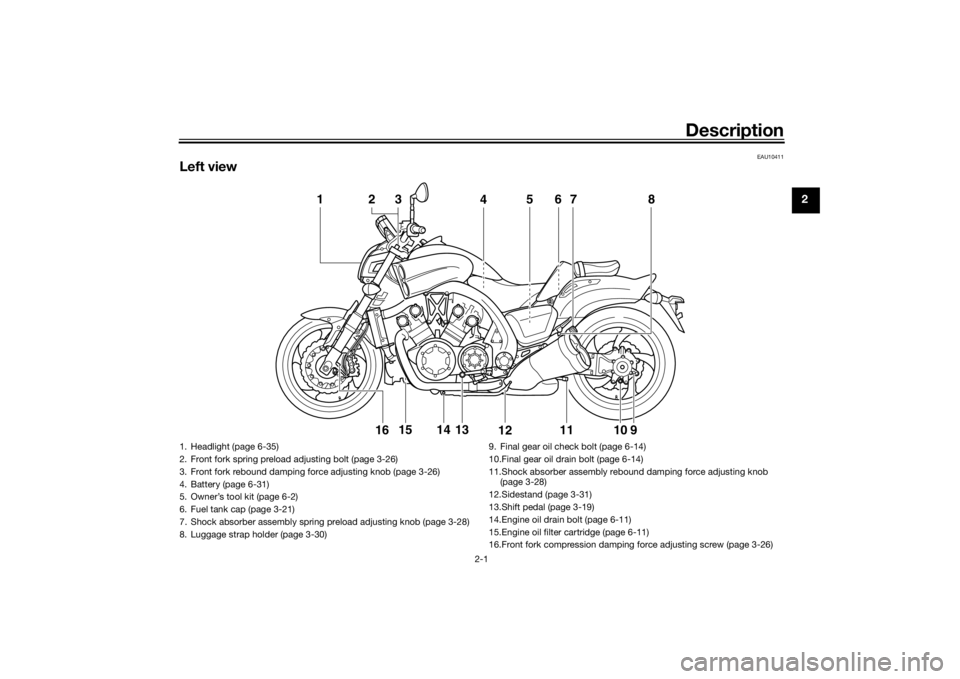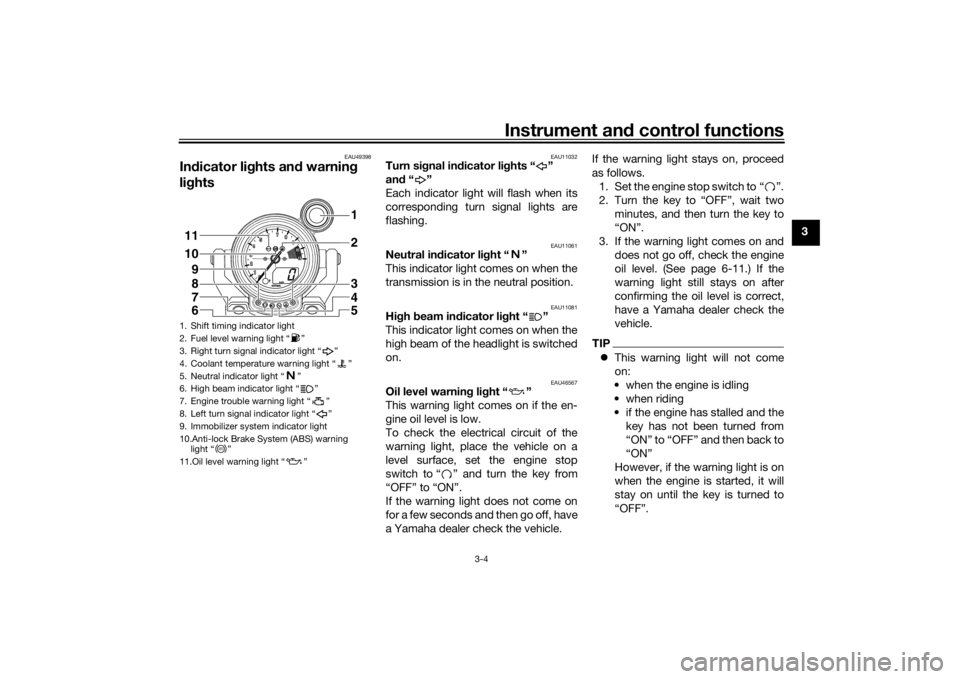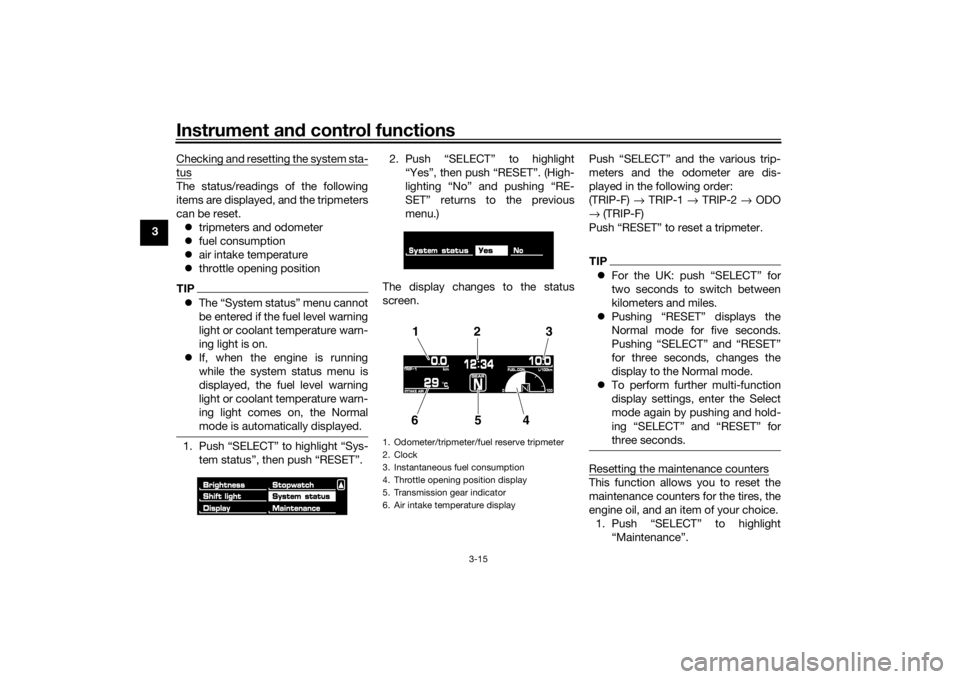check engine YAMAHA VMAX 2016 Owners Manual
[x] Cancel search | Manufacturer: YAMAHA, Model Year: 2016, Model line: VMAX, Model: YAMAHA VMAX 2016Pages: 112, PDF Size: 3.25 MB
Page 6 of 112

Table of contentsSafety information ............................ 1-1
Description ....................................... 2-1
Left view ......................................... 2-1
Right view ....................................... 2-2
Controls and instruments ............... 2-3
Instrument an d control functions ... 3-1
Immobilizer system......................... 3-1
Main switch/steering lock............... 3-2
Indicator lights and warning lights............................................ 3-4
Speedometer unit ........................... 3-7
Multi-function display ..................... 3-8
Handlebar switches ...................... 3-17
Clutch lever .................................. 3-18
Shift pedal .................................... 3-19
Brake lever.................................... 3-19
Brake pedal .................................. 3-20
ABS .............................................. 3-20
Fuel tank cap ................................ 3-21
Fuel ............................................... 3-22
Fuel tank breather hose and overflow hose ............................ 3-24
Catalytic converters ..................... 3-24
Seats ............................................ 3-25
Adjusting the front fork ................. 3-26
Adjusting the shock absorber assembly ................................... 3-28
Luggage strap holders ................. 3-30
EXUP system ................................ 3-31 Sidestand ...................................... 3-31
Ignition circuit cut-off system ....... 3-32
For your safety – pre-operation
checks ............................................... 4-1
Operation an d important ri din g
points ................................................. 5-1
Starting the engine .......................... 5-1
Shifting ............................................ 5-2
Tips for reducing fuel consumption ................................ 5-3
Engine break-in ............................... 5-3
Parking ............................................ 5-4
Perio dic maintenance an d
a d justment ........................................ 6-1
Owner’s tool kits ............................. 6-2
Periodic maintenance chart for the emission control system .............. 6-3
General maintenance and lubrication chart ........................... 6-4
Removing and installing the
cowling and panels ...................... 6-8
Checking the spark plugs ............. 6-10
Engine oil and oil filter cartridge.... 6-11
Final gear oil .................................. 6-14
Coolant.......................................... 6-16
Air filter element ............................ 6-19
Checking the engine idling speed ......................................... 6-20 Checking the throttle grip free
play ............................................ 6-20
Valve clearance............................. 6-20
Tires .............................................. 6-21
Cast wheels .................................. 6-23
Clutch lever................................... 6-23
Checking the brake lever free play ............................................ 6-24
Brake light switches ..................... 6-24
Checking the front and rear brake pads ................................ 6-25
Checking the brake fluid level ...... 6-25
Changing the brake and clutch fluids .......................................... 6-27
Checking and lubricating the cables ........................................ 6-27
Checking and lubricating the
throttle grip and cable ............... 6-27
Checking and lubricating the brake and shift pedals............... 6-28
Checking and lubricating the brake and clutch levers ............. 6-28
Checking and lubricating the
sidestand................................... 6-29
Lubricating the swingarm pivots......................................... 6-29
Checking the front fork ................. 6-30
Checking the steering................... 6-30
Checking the wheel bearings ....... 6-31
Battery .......................................... 6-31
Replacing the fuses ...................... 6-34U2CEE1E0.book Page 1 Thursday, November 19, 2015 10:32 AM
Page 10 of 112

Safety information
1-3
1Avoi
d Car bon Monoxi de Poisonin g
All engine exhaust contains carbon
monoxide, a deadly gas. Breathing
carbon monoxide can cause head-
aches, dizziness, drowsiness, nausea,
confusion, and eventually death.
Carbon Monoxide is a colorless, odor-
less, tasteless gas which may be pres-
ent even if you do not see or smell any
engine exhaust. Deadly levels of car-
bon monoxide can collect rapidly and
you can quickly be overcome and un-
able to save yourself. Also, deadly lev-
els of carbon monoxide can linger for
hours or days in enclosed or poorly
ventilated areas. If you experience any
symptoms of carbon monoxide poi-
soning, leave the area immediately, get
fresh air, and SEEK MEDICAL TREAT-
MENT. Do not run engine indoors. Even if
you try to ventilate engine exhaust
with fans or open windows and
doors, carbon monoxide can rap-
idly reach dangerous levels.
Do not run engine in poorly venti-
lated or partially enclosed areas
such as barns, garages, or car-
ports.
Do not run engine outdoors where
engine exhaust can be drawn into
a building through openings such
as windows and doors.
Loa din g
Adding accessories or cargo to your
motorcycle can adversely affect stabil-
ity and handling if the weight distribu-
tion of the motorcycle is changed. To
avoid the possibility of an accident, use
extreme caution when adding cargo or
accessories to your motorcycle. Use
extra care when riding a motorcycle
that has added cargo or accessories.
Here, along with the information about
accessories below, are some general
guidelines to follow if loading cargo to
your motorcycle:
The total weight of the operator, pas-
senger, accessories and cargo must
not exceed the maximum load limit.
Operation of an overloa ded vehicle
coul d cause an acci dent. When loading within this weight limit,
keep the following in mind:
Cargo and accessory weight
should be kept as low and close to
the motorcycle as possible. Se-
curely pack your heaviest items as
close to the center of the vehicle
as possible and make sure to dis-
tribute the weight as evenly as
possible on both sides of the mo-
torcycle to minimize imbalance or
instability.
Shifting weights can create a sud-
den imbalance. Make sure that
accessories and cargo are se-
curely attached to the motorcycle
before riding. Check accessory
mounts and cargo restraints fre-
quently.
• Properly adjust the suspension for your load (suspension-ad-
justable models only), and
check the condition and pres-
sure of your tires.
• Never attach any large or heavy items to the handlebar, front
fork, or front fender. These
items, including such cargo as
sleeping bags, duffel bags, or
Maximum loa d:
190 kg (419 lb)
U2CEE1E0.book Page 3 Thursday, November 19, 2015 10:32 AM
Page 12 of 112

Safety information
1-5
1operator and may limit control
ability, therefore, such accesso-
ries are not recommended.
Use caution when adding electri-
cal accessories. If electrical ac-
cessories exceed the capacity of
the motorcycle’s electrical sys-
tem, an electric failure could re-
sult, which could cause a
dangerous loss of lights or engine
power.
Aftermarket Tires an d Rims
The tires and rims that came with your
motorcycle were designed to match
the performance capabilities and to
provide the best combination of han-
dling, braking, and comfort. Other
tires, rims, sizes, and combinations
may not be appropriate. Refer to page
6-21 for tire specifications and more in-
formation on replacing your tires.
Transportin g the Motorcycle
Be sure to observe following instruc-
tions before transporting the motorcy-
cle in another vehicle. Remove all loose items from the
motorcycle.
Check that the fuel cock (if
equipped) is in the “OFF” position
and that there are no fuel leaks.
Point the front wheel straight
ahead on the trailer or in the truck
bed, and choke it in a rail to pre-
vent movement.
Shift the transmission in gear (for
models with a manual transmis-
sion).
Secure the motorcycle with tie-
downs or suitable straps that are
attached to solid parts of the mo-
torcycle, such as the frame or up-
per front fork triple clamp (and not,
for example, to rubber-mounted
handlebars or turn signals, or
parts that could break). Choose
the location for the straps carefully
so the straps will not rub against
painted surfaces during transport.
The suspension should be com-
pressed somewhat by the tie-
downs, if possible, so that the mo-
torcycle will not bounce exces-
sively during transport.
U2CEE1E0.book Page 5 Thursday, November 19, 2015 10:32 AM
Page 13 of 112

Description
2-1
2
EAU10411
Left view
1
4
56
7
8
11
9
10
12
13
14
15
2316
1. Headlight (page 6-35)
2. Front fork spring preload adjusting bolt (page 3-26)
3. Front fork rebound damping force adjusting knob (page 3-26)
4. Battery (page 6-31)
5. Owner’s tool kit (page 6-2)
6. Fuel tank cap (page 3-21)
7. Shock absorber assembly spring preload adjusting knob (page 3-28)
8. Luggage strap holder (page 3-30) 9. Final gear oil check bolt (page 6-14)
10.Final gear oil drain bolt (page 6-14)
11.Shock absorber assembly rebound damping force adjusting knob
(page 3-28)
12.Sidestand (page 3-31)
13.Shift pedal (page 3-19)
14.Engine oil drain bolt (page 6-11)
15.Engine oil filter cartridge (page 6-11)
16.Front fork compression damping force adjusting screw (page 3-26)
U2CEE1E0.book Page 1 Thursday, November 19, 2015 10:32 AM
Page 14 of 112

Description
2-2
2
EAU10421
Right view
12 4 6
7
5
3
9
11
8
10
1. Passenger seat (page 3-25)
2. Rear brake fluid reservoir (page 6-25)
3. Luggage strap holder (page 3-30)
4. Rider seat (page 3-25)
5. Fuse box 1 (page 6-34)
6. Radiator cap (page 6-16)
7. Coolant reservoir (page 6-16)
8. Engine oil level check window (page 6-11) 9. Brake pedal (page 3-20)
10.Fuse box 2 (page 6-34)
11.Shock absorber assembly compression damping force adjusting
knob (page 3-28)U2CEE1E0.book Page 2 Thursday, November 19, 2015 10:32 AM
Page 19 of 112

Instrument and control functions
3-4
3
EAU49398
In dicator lig hts and warning
lig hts
EAU11032
Turn si gnal in dicator li ghts “ ”
an d“”
Each indicator light will flash when its
corresponding turn signal lights are
flashing.
EAU11061
Neutral in dicator li ght “ ”
This indicator light comes on when the
transmission is in the neutral position.
EAU11081
Hi gh beam in dicator li ght “ ”
This indicator light comes on when the
high beam of the headlight is switched
on.
EAU46567
Oil level warnin g lig ht “ ”
This warning light comes on if the en-
gine oil level is low.
To check the electrical circuit of the
warning light, place the vehicle on a
level surface, set the engine stop
switch to “ ” and turn the key from
“OFF” to “ON”.
If the warning light does not come on
for a few seconds and then go off, have
a Yamaha dealer check the vehicle. If the warning light stays on, proceed
as follows.
1. Set the engine stop switch to “ ”.
2. Turn the key to “OFF”, wait two minutes, and then turn the key to
“ON”.
3. If the warning light comes on and does not go off, check the engine
oil level. (See page 6-11.) If the
warning light still stays on after
confirming the oil level is correct,
have a Yamaha dealer check the
vehicle.
TIPThis warning light will not come
on:
• when the engine is idling
• when riding
• if the engine has stalled and the key has not been turned from
“ON” to “OFF” and then back to
“ON”
However, if the warning light is on
when the engine is started, it will
stay on until the key is turned to
“OFF”.
1. Shift timing indicator light
2. Fuel level warning light “ ”
3. Right turn signal indicator light “ ”
4. Coolant temperature warning light “ ”
5. Neutral indicator light “ ”
6. High beam indicator light “ ”
7. Engine trouble warning light “ ”
8. Left turn signal indicator light “ ”
9. Immobilizer system indicator light
10.Anti-lock Brake System (ABS) warning light “ ”
11.Oil level warning light “ ”11
10 2
1
9
3
4
5
8
7
6
ABS
U2CEE1E0.book Page 4 Thursday, November 19, 2015 10:32 AM
Page 20 of 112

Instrument and control functions
3-5
3
This model is equipped with a self-
diagnosis device for the oil level
detection circuit. If a problem is
detected in the oil level detection
circuit, the oil level warning light
will flash repeatedly. If this occurs,
have a Yamaha dealer check the
vehicle.
EAU48702
Fuel level warnin g li ght “ ”
This warning light comes on when the
fuel level drops below approximately
3.9 L (1.03 US gal, 0.86 Imp.gal). When
this occurs, refuel as soon as possible.
The electrical circuit of the warning
light can be checked by turning the key
to “ON”. The warning light should
come on for a few seconds, and then
go off.
If the warning light does not come on
initially when the key is turned to “ON”,
or if the warning light remains on after
refueling, have a Yamaha dealer check
the vehicle.TIPThis model is equipped with a self-di-
agnosis device for the fuel level detec-
tion circuit. If a problem is detected in the fuel level detection circuit, the fuel
level warning light, the fuel meter and
the fuel level warning indicator will
flash repeatedly. If this occurs, have a
Yamaha dealer check the vehicle.
EAU11447
Coolant temperature warnin g
li g ht “ ”
This warning light comes on if the en-
gine overheats. If this occurs, stop the
engine immediately and allow the en-
gine to cool.
The electrical circuit of the warning
light can be checked by turning the key
to “ON”. The warning light should
come on for a few seconds, and then
go off.
If the warning light does not come on
initially when the key is turned to “ON”,
or if the warning light remains on, have
a Yamaha dealer check the electrical
circuit.NOTICE
ECA10022
Do not continue to operate the en-
g ine if it is overheatin g.
TIP For radiator-fan-equipped vehi-
cles, the radiator fan(s) automati-
cally switch on or off according to
the coolant temperature in the ra-
diator.
If the engine overheats, see page
6-42 for further instructions.
EAU46443
Engine trou ble warnin g lig ht “ ”
This warning light comes on if a prob-
lem is detected in the electrical circuit
monitoring the engine. If this occurs,
have a Yamaha dealer check the self-
diagnosis system. (See page 3-16 for
an explanation of the self-diagnosis
device.)
The electrical circuit of the warning
light can be checked by turning the key
to “ON”. The warning light should
come on for a few seconds, and then
go off.
If the warning light does not come on
initially when the key is turned to “ON”,
or if the warning light remains on, have
a Yamaha dealer check the electrical
circuit.
U2CEE1E0.book Page 5 Thursday, November 19, 2015 10:32 AM
Page 21 of 112

Instrument and control functions
3-6
3
TIPThis warning light will come on when
the key is turned to “ON” and the start
switch is pushed, but this does not in-
dicate a malfunction.
EAU51662
ABS warnin g lig ht “ ”
In normal operation, the ABS warning
light comes on when the key is turned
to “ON”, and goes off after traveling at
a speed of 10 km/h (6 mi/h) or higher.
If the ABS warning light: does not come on when the key is
turned to “ON”
comes on or flashes while riding
does not go off after traveling at a
speed of 10 km/h (6 mi/h) or high-
er
The ABS may not work correctly. If any
of the above occurs, have a Yamaha
dealer check the system as soon as
possible. (See page 3-20 for an expla-
nation of the ABS.)
WARNING
EWA16041
If the ABS warnin g li ght does not go
off after travelin g at a speed of 10
km/h (6 mi/h) or hi gher, or if the warnin
g lig ht comes on or flashes
while ri din g, the b rake system re-
verts to conventional b raking. If ei-
ther of the a bove occurs, or if the
warnin g lig ht does not come on at
all, use extra caution to avoi d possi-
b le wheel lock d uring emer gency
b rakin g. Have a Yamaha d ealer
check the brake system an d electri-
cal circuits as soon as possi ble.
TIPIf the start switch is pushed while the
engine is running, the ABS warning
light will come on, but this is not a mal-
function.
EAU48522
Shift timin g in dicator li ght
This indicator light can be set to come
on and go off at the desired engine
speeds and is used to inform the rider
when it is time to shift to the next high-
er gear. (See “Select mode” on page
3-10 for an explanation on how to set
this indicator light.) The electrical circuit of the indicator
light can be checked by turning the key
to “ON”. The indicator light should
come on for a few seconds, and then
go off.
If the indicator light does not come on
initially when the key is turned to “ON”,
or if the indicator light remains on, have
a Yamaha dealer check the electrical
circuit.
EAU38626
Immo
bilizer system in dicator li ght
When the key is turned to “OFF” and
30 seconds have passed, the indicator
light will start flashing indicating the im-
mobilizer system is enabled. After 24
hours have passed, the indicator light
will stop flashing, however the immobi-
lizer system is still enabled.
The electrical circuit of the indicator
light can be checked by turning the key
to “ON”. The indicator light should
come on for a few seconds, and then
go off.
ABS
U2CEE1E0.book Page 6 Thursday, November 19, 2015 10:32 AM
Page 22 of 112

Instrument and control functions
3-7
3 If the indicator light does not come on
initially when the key is turned to “ON”,
or if the indicator light remains on, have
a Yamaha dealer check the electrical
circuit.
The self-diagnosis device also detects
problems in the immobilizer system
circuits. (See page 3-16 for an expla-
nation of the self-diagnosis device.)
EAU46627
Speed
ometer unitSpeed ometer
The speedometer shows the vehicle’s
traveling speed.TIPFor the UK
The speedometer can be switched be-
tween kilometers and miles. To switch
the speedometer, press the “SELECT”
button for at least two seconds.A “SELECT” button and a “RESET”
button are located on the handlebar
holder. Tachometer
The tachometer allows the rider to
monitor the engine speed and keep it
within the ideal power range. When the
key is turned to “ON”, the tachometer
needle will sweep once across the
r/min range and then return to zero
r/min in order to test the electrical cir-
cuit.
NOTICE
ECA10032
Do not operate the en
gine in the ta-
chometer red zone.
Re d zone: 9500 r/min an d a bove
1. Tachometer
2. Shift timing indicator light
3. Tachometer red zone
4. Speedometer
1 2
4
3
1. “SELECT” button
2. “RESET” button
12
U2CEE1E0.book Page 7 Thursday, November 19, 2015 10:32 AM
Page 30 of 112

Instrument and control functions
3-15
3 Checking and resetting the system sta-
tusThe status/readings of the following
items are displayed, and the tripmeters
can be reset.
tripmeters and odometer
fuel consumption
air intake temperature
throttle opening positionTIPThe “System status” menu cannot
be entered if the fuel level warning
light or coolant temperature warn-
ing light is on.
If, when the engine is running
while the system status menu is
displayed, the fuel level warning
light or coolant temperature warn-
ing light comes on, the Normal
mode is automatically displayed.1. Push “SELECT” to highlight “Sys-
tem status”, then push “RESET”. 2. Push “SELECT” to highlight
“Yes”, then push “RESET”. (High-
lighting “No” and pushing “RE-
SET” returns to the previous
menu.)
The display changes to the status
screen. Push “SELECT” and the various trip-
meters and the odometer are dis-
played in the following order:
(TRIP-F)
→ TRIP-1 → TRIP-2 → ODO
→ (TRIP-F)
Push “RESET” to reset a tripmeter.
TIP For the UK: push “SELECT” for
two seconds to switch between
kilometers and miles.
Pushing “RESET” displays the
Normal mode for five seconds.
Pushing “SELECT” and “RESET”
for three seconds, changes the
display to the Normal mode.
To perform further multi-function
display settings, enter the Select
mode again by pushing and hold-
ing “SELECT” and “RESET” for
three seconds.Resetting the maintenance countersThis function allows you to reset the
maintenance counters for the tires, the
engine oil, and an item of your choice.
1. Push “SELECT” to highlight “Maintenance”.
1. Odometer/tripmeter/fuel reserve tripmeter
2. Clock
3. Instantaneous fuel consumption
4. Throttle opening position display
5. Transmission gear indicator
6. Air intake temperature display
12 3
654
U2CEE1E0.book Page 15 Thursday, November 19, 2015 10:32 AM